Performance Retrospective: AMD’s Radeon HD 7970M
by Jarred Walton on June 21, 2013 5:25 PM ESTMainstream/High 1600x900 Gaming Performance
Moving up to our “Mainstream” gaming tests (high detail, no 4xAA, 1600x900 resolution), there’s a lot more demanded of the GPU this time around, so CPU and platform limitations aren’t likely to be as large of a factor. Integrated graphics solutions (outside of perhaps Intel’s Iris Pro Graphics) are also going to prove insufficient for our test suite in nearly all of these games. Let’s look at round two of the 7970M performance.
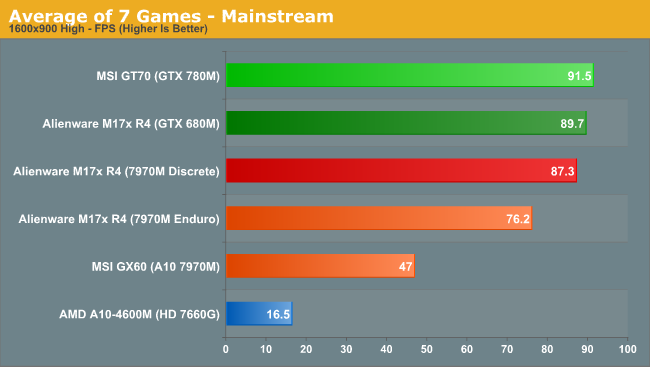
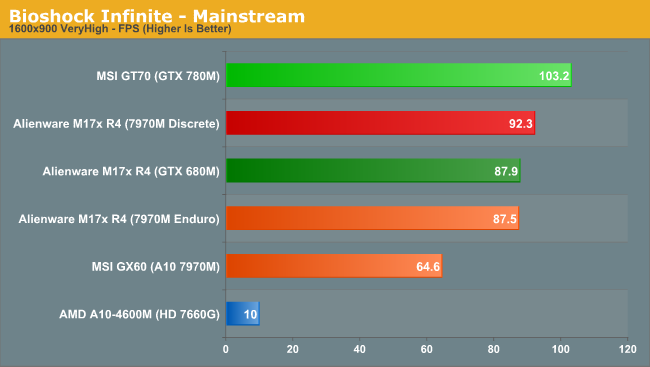
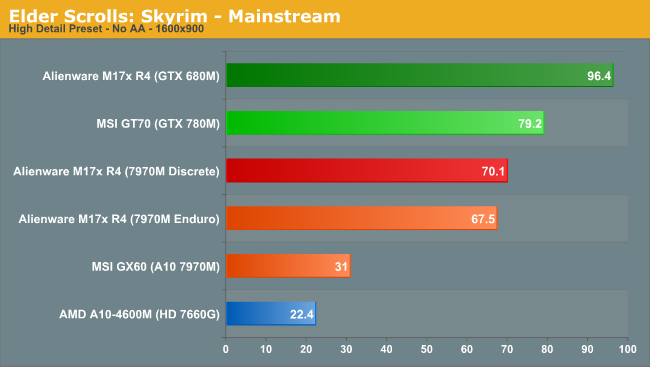
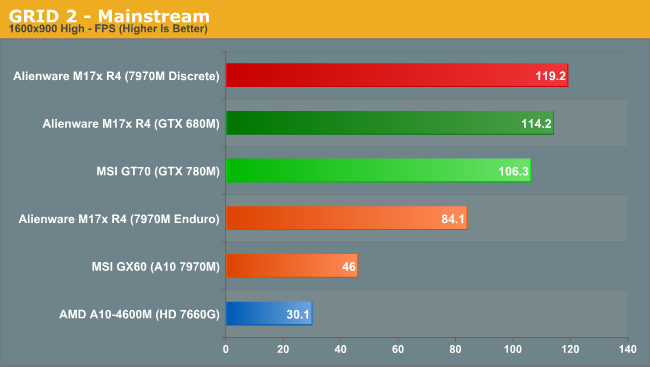



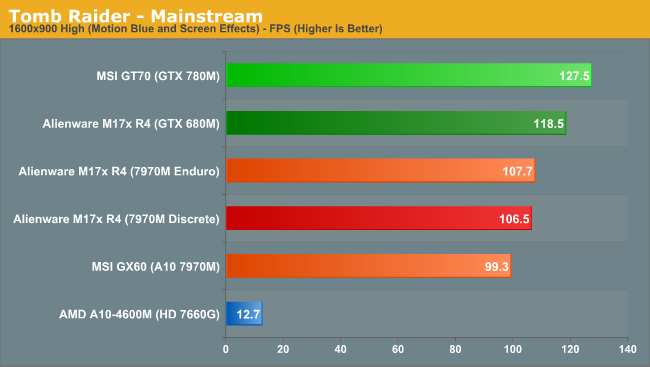
Despite the increase in graphics complexity, at least on the Alienware M17x R4 the use of Enduro is still bringing a performance penalty in some titles. On average, switching to discrete mode improves performance by 14%, slightly less than we saw with our Value settings; however, the individual games show varying amounts of separation. Bioshock is now nearly the same, with only a 5% performance increase, and in fact most of the games show less than a 5% increase by using discrete mode (though again it’s worth mentioning the rendering errors on DX9 titles with the 13.6 beta drivers). The two titles that show a significant performance increase by using discrete mode are GRID 2 (42%) and Sleeping Dogs (46%); interestingly, Tomb Raider is actually slightly faster with Enduro at these settings, though the 1% difference is within the margin of error.
The Intel Enduro vs. AMD Enduro results are much closer this round, though Intel still holds a commanding lead. No longer is the Core i7 offering twice the frame rates in most games; at 900p High it’s “only” 62% faster on average—but that’s mostly due to the closer performance in two of the seven games. Skyrim, Sleeping Dogs, and StarCraft II are still the big losers, with more than twice the performance on Intel’s CPU, but GRID 2 and Metro are nearly as bad at 83% and 91% performance improvements, respectively. In fact, of those five titles, Skyrim and Sleeping Dogs flirt with the 30FPS “playable” boundary, and Metro and StarCraft II actually fall below 30FPS. Getting to the last two games, Bioshock isn’t too bad, showing a mere 35% performance increase, and Tomb Raider is the one exception where platform doesn’t make much of a difference. Tomb Raider has proven to be almost wholly dependent on GPU performance, and the advantage for the Intel platform is an insignificant 8%. At our Mainstream presets, the 7970M also proves much faster than the 7660G, as it should; this time, it’s nearly three times as fast.
Finally, the NVIDIA vs. 7970M matchup continues to be quite close on average. The GTX 680M leads by 3% overall, with the only significant lead coming in Skyrim (38%); the 680M also claims smaller (<10%) leads in StarCraft II and Tomb Raider (that last one being an AMD title). Meanwhile, the 7970M holds small leads in Bioshock, GRID 2, Metro: Last Light (an NVIDIA title, so turnabout is fair play), and Sleeping Dogs. The 780M continues to be hamstrung by CPU throttling in the GT70, and we hope to have a new test notebook shortly to see what the 780M can really do when it’s allowed to stretch its legs. For now, the lead over the 7970M is 5% on average, with a smaller lead in Skyrim and only two small losses (GRID 2 and Sleeping Dogs).










58 Comments
View All Comments
kogunniyi - Saturday, June 22, 2013 - link
The question of liability is not that simple.I assume that most people who buy the GX60 expect a CPU bottleneck within certain limits. Imagine that the A10-4600m cuts performance in half for every application. If the 7970m is performing at 10% of its potential, the APU is probably not the only problem. Even Enduro does not account for such a performance hit. Most people would define "getting money's worth" as taking the 50% hit in every game. In the case given, they are not getting their money's worth, and the locked-down overclocking does not help.
On the other hand, MSI does not advertise a certain performance. You could argue that the benchmarks it posted for the GX60 are misleading, but that's marketing fluff and should not be taken seriously. Because MSI does not promise anything, it isn't legally responsible, but it can be held ethically accountable: the very act of offering the APU + 7970m suggests that it is a stable and consistent platform. I assume that Jarred simply wants to tell readers that the MSI GX60 may not perform up to standard.
kallogan - Friday, June 21, 2013 - link
7970M is da best considering its lower price. I didn't think the A10 would be such a bottleneck even at 1080p.Wreckage - Friday, June 21, 2013 - link
Waste of money. Lower price because of lower quality.Xinn3r - Saturday, June 22, 2013 - link
+1You can't get away with low quality just by lowering your price
Meaker10 - Friday, June 21, 2013 - link
2.7ghz is the maximum turbo speed for more than 2 threads on the 4600M APU. 3.2ghz is mostly for single thread only.JarredWalton - Friday, June 21, 2013 - link
True. I guess I was expecting some of the games to not hit the second thread hard enough to trigger that limit. Let me edit text a bit....Meaker10 - Friday, June 21, 2013 - link
Engineering cpus are unlocked, if amd had allowed overclocking on platforms like the msi and could be run around 3.5ghz performance would be far more acceptable imo.Khenglish - Saturday, June 22, 2013 - link
Yeah I agree. I don't understand why the top end APU is completely locked. AMD is going for performance/cost, and allowing overclocking would have helped that. 2.7ghz is OK for intel, but for AMD's lower IPC it's a problem. They don't even let you overclock trinity's GPU on laptops.As for the argument that it's to make sure people don't kill their hardware, on the APU laptop I played around with it was possible to disable thermal throttling, thermal shutdown (only possible due to BIOS bug, but still), and the cpu fan though PCI config space options... but overclocking was locked down tight!
Roland00Address - Saturday, June 22, 2013 - link
Furthermore you if you are using more than 2 threads you are using both cores and cmt simultaneously, thus you will use the cmt tax and only get 80% performance.Bob Todd - Friday, June 21, 2013 - link
While the end result for the Enduro drivers on older systems is exactly the weak sauce I expected, I have to say I'm disappointed in how they handled it from a product management perspective. They should have only included systems they absolutely knew they would support (IVB/Trinity), and actually been realistic about previous gen platforms and said something like "We are evaluating the potential for SB/Llano support and we'll have an answer for you in 6 months" (or whatever a realistic timeline would have been). Instead they basically strung along their customers of the older platforms for months with 'a future driver will support your system' pipe dream. Middle finger to you for that one PMs or marketing folks. Who I feel even worse for than Sandy Bridge/(rebadged) 7XXX owners are folks in the same boat with Llano. Those are customers who invested in an ALL AMD solution and these jokers can't even invest in a solution for them? That's bush league AMD.